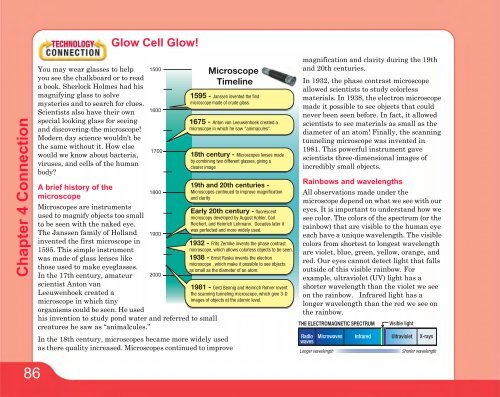Cell Biology
Cell Biology
Cell Biology
Create successful ePaper yourself
Turn your PDF publications into a flip-book with our unique Google optimized e-Paper software.
Chapter 4 ConnectionYou may wear glasses to helpyou see the chalkboard or to reada book. Sherlock Holmes had hismagnifying glass to solvemysteries and to search for clues.Scientists also have their ownspecial looking glass for seeingand discovering-the microscope!Modern day science wouldn't bethe same without it. How elsewould we know about bacteria,viruses, and cells of the humanbody?A brief history of themicroscopeMicroscopes are instrumentsused to magnify objects too smallto be seen with the naked eye.The Janssen family of Hollandinvented the first microscope in1595. This simple instrumentwas made of glass lenses likethose used to make eyeglasses.In the 17th century, amateurscientist Anton vanLeeuwenhoek created amicroscope in which tinyorganisms could be seen. He usedGlow <strong>Cell</strong> Glow!150016001700180019002000his invention to study pond water and referred to smallcreatures he saw as “animalcules.”MicroscopeTimeline1595 - Janssen invented the firstmicroscope made of crude glass.1675 - Anton van Leeuwenhoek created amicroscope in which he saw "animacules".In the 18th century, microscopes became more widely usedas there quality increased. Microscopes continued to improve18th century - Microscopes lenses madeby combining two different glasses, giving aclearer image19th and 20th centuries -Microscopes continued to improve magnificationand clarityEarly 20th century - fluorescentmicroscopy developed by August Kohler, CarlReichert, and Heinrich Lehmann. Decades later itwas perfected and more widely used.1932 - Frits Zernike invents the phase contrastmicroscope, which allows colorless objects to be seen.1938 - Ernst Ruska invents the electronmicroscope , which make it possible to see objectsas small as the diameter of an atom.1981 - Gerd Bennig and Heinrich Rohrer inventthe scanning tunneling microscope, which give 3-Dimages of objects at the atomic level.magnification and clarity during the 19thand 20th centuries.In 1932, the phase contrast microscopeallowed scientists to study colorlessmaterials. In 1938, the electron microscopemade it possible to see objects that couldnever been seen before. In fact, it allowedscientists to see materials as small as thediameter of an atom! Finally, the scanningtunneling microscope was invented in1981. This powerful instrument gavescientists three-dimensional images ofincredibly small objects.Rainbows and wavelengthsAll observations made under themicroscope depend on what we see with oureyes. It is important to understand how wesee color. The colors of the spectrum (or therainbow) that are visible to the human eyeeach have a unique wavelength. The visiblecolors from shortest to longest wavelengthare violet, blue, green, yellow, orange, andred. Our eyes cannot detect light that fallsoutside of this visible rainbow. Forexample, ultraviolet (UV) light has ashorter wavelength than the violet we seeon the rainbow. Infrared light has alonger wavelength than the red we see onthe rainbow.THE ELECTROMAGNETIC SPECTRUMRadiowavesVisible lightMicrowaves Infrared Ultraviolet X-raysLonger wavelengthShorter wavelength86


